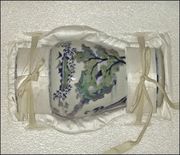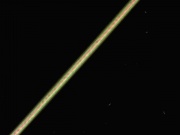Difference between revisions of "Ethafoam"
| Line 20: | Line 20: | ||
== Personal Risks == | == Personal Risks == | ||
| − | + | See the attached PDF, Ethafoam220-MSDS for the Material Safety Data Sheet provided by Dow. Ethafoam is manufactured with blowing agents that can be released from broken cells into the atmosphere when it is cut or melted. These blowing agents are toxic and technically flammable, but they will not combust by accidentally melting the foam with the tip of a hot glue gun, or by heat-welding to another piece of foam. A well ventilated workspace is recommended when fabricating to mitigate the minor toxicity. | |
== Environmental Risks == | == Environmental Risks == | ||
Revision as of 13:28, 23 November 2019
Description
[Dow Chemical Company] A registered trademark Ethafoam is the brand name of polyethylene foam plank manufactured by Sealed Air Corporation (formally by Dow Chemical Company). It is a durable, flexible, closed-cell foam with excellent memory when used in an appropriate coverage and density for the load. It is watertight and impervious to most chemicals. It performs consistently through a wide range of temperatures. It is easily cut with knives, hot knives, band saws, powered foam rubber cutters, and table saws. Ethafoam adheres to itself and other polyethylene-based materials with heat-welding, or to most other surfaces with industrial-grade hot glue. The natural color of polyethylene foam is brilliant, sparkling white with a slight translucence in thin areas, but black and blue are also available in a limited range of sizes. Ethafoam is not cross-linked, so it is easily recyclable.
Sheets and planks have a skin on each of the large faces. The skin is an unbroken surface, but has a bubbly texture with approximately 1mm relief, and despite the absence of additives the foam feels waxy to the touch. The edges of the planks expose open cells where they have been broken. Individual cells range between 1-2mm diameter at medium density. Plank edges and other cut surfaces create a rougher texture than that of the closed skin. Both surfaces are generally considered too abrasive for making direct contact with sensitive surfaces, and require the mediation of a smoother material between the Ethafoam and the object, such as Tyvek Softwrap, Volara, or poly-sheeting for a few examples. This mediation can be achieved either by lining the foam or wrapping the object.
Ethafoam 220 appears very similar to PolyPlank EXT220 and PolyPlank LAM220, another brand name of polyethylene foam, but the two PE foams are manufactured with slightly different methods and chemical compositions. PolyPlank has a larger cell structure on average, and the broken cell walls of cut surfaces feel rougher. It offers less resistance to compression and puncturing than Ethafoam of the same weight. PolyPlank LAM offers two more light-density options than Ethafoam; 0.9 pcf and 1.2 pcf.
Synonyms and Related Terms
Applications
- Lining cavities cut in foam
- Can be sewn and bonded with hot melt adhesives without melting
Ethafoam is typically used in art handling as a versatile and chemically stable shock-absorption and vibration-dampening material applied in small amounts relative to the size of an object. In other words; multiple pads, strips or blocks are more common than continuous contact over broad areas.
It is more firm than open-cell foams of equivalent pcf densities, such as polyurethanes. In fact, 220 is not soft enough to be highly recommended for cavity packing lightweight objects or, as noted above, full-contact cushioning over broad surfaces. However, it carves well with sharp knives for precise contouring of cushioning pads. 220 is stiff enough to employ as yokes for large rolling tubes or guillotines for moderately sized sculptures. Heavier objects can be secured with pads & wood bracing, and with the further option of greater foam densities. 900 is typically reserved for support underneath objects weighing several hundred lbs or more or in storage and mountmaking applications where it's rigidity makes it work almost like wood.
It will also provide some thermal insulation when applied as lining for a container, and the closed-cell structure makes it waterproof.
Personal Risks
See the attached PDF, Ethafoam220-MSDS for the Material Safety Data Sheet provided by Dow. Ethafoam is manufactured with blowing agents that can be released from broken cells into the atmosphere when it is cut or melted. These blowing agents are toxic and technically flammable, but they will not combust by accidentally melting the foam with the tip of a hot glue gun, or by heat-welding to another piece of foam. A well ventilated workspace is recommended when fabricating to mitigate the minor toxicity.
Environmental Risks
Collection Risks
May be susceptible to snagging on corners.
Physical and Chemical Properties
Resistant to acids, alkalis, bleaches and most solvents. Fiber is smooth. Permeable to air and moisture. Fiber cross section = dogbone. Fire resistant and self-extinguishing. Degrades in ultraviolet light.
| Melting Point | 370 |
|---|---|
| Density | 1.38 |
| Tenactiy | 5.3 g/denier (dry) |
| Elongation | 22% |
| Moisture regain | 3.5% |
Working Properties
The spunwoven version of Nomex is typically used in museum applications. It has the unique ability to stretch in one direction, preventing bunching and folding of loose material within a cavity (PACCIN).
Forms/Sizes
Forms include fibers, paper/fabric, felts, and rigid honeycomb boards. Flexible fabric typically comes rolls with widths of 39”. Thicknesses range from 3 to 30 mils.

